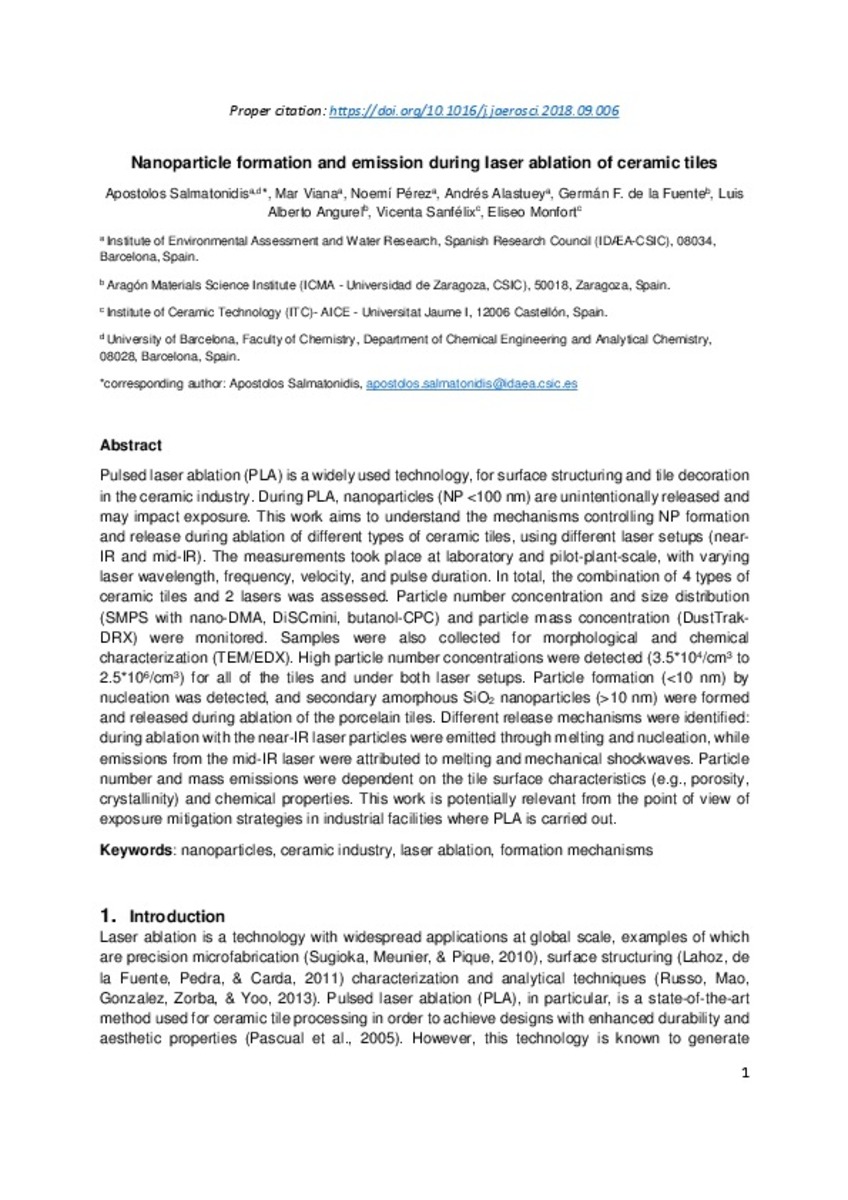Mostrar el registro sencillo del ítem
Nanoparticle formation and emission during laser ablation of ceramic tiles
| dc.contributor.author | Salmatonidis, Apostolos | |
| dc.contributor.author | Viana, Mar | |
| dc.contributor.author | Pérez, Noemí | |
| dc.contributor.author | Alastuey, Andres | |
| dc.contributor.author | De la Fuente, Germán F. | |
| dc.contributor.author | Angurel Lambán, Luis Alberto | |
| dc.contributor.author | Sanfélix Forner, Vicenta | |
| dc.contributor.author | Monfort, Eliseo | |
| dc.date.accessioned | 2018-12-20T08:58:24Z | |
| dc.date.available | 2018-12-20T08:58:24Z | |
| dc.date.issued | 2018-12 | |
| dc.identifier.citation | SALMATONIDIS, Apostolos, et al. Nanoparticle formation and emission during laser ablation of ceramic tiles. Journal of Aerosol Science, 2018, 126: 152-168. | ca_CA |
| dc.identifier.uri | http://hdl.handle.net/10234/178298 | |
| dc.description.abstract | Pulsed laser ablation (PLA) is a widely used technology, for surface structuring and tile decoration in the ceramic industry. During PLA, nanoparticles (NP <100 nm) are unintentionally released and may impact exposure. This work aims to understand the mechanisms controlling NP formation and release during ablation of different types of ceramic tiles, using different laser setups (near-IR and mid-IR). The measurements took place at laboratory and pilot-plant-scale, with varying laser wavelength, frequency, velocity, and pulse duration. In total, the combination of 4 types of ceramic tiles and 2 lasers was assessed. Particle number concentration and size distribution (SMPS with nano-DMA, DiSCmini, butanol-CPC) and particle mass concentration (DustTrak-DRX) were monitored. Samples were also collected for morphological and chemical characterization (TEM/EDX). High particle number concentrations were detected (3.5 *104/cm3 to 2.5 *106/cm3) for all of the tiles and under both laser setups. Particle formation (<10 nm) by nucleation was detected, and secondary amorphous SiO2 nanoparticles (>10 nm) were formed and released during ablation of the porcelain tiles. Different release mechanisms were identified: during ablation with the near-IR laser particles were emitted through melting and nucleation, while emissions from the mid-IR laser were attributed to melting and mechanical shockwaves. Particle number and mass emissions were dependent on the tile surface characteristics (e.g., porosity, crystallinity) and chemical properties. This work is potentially relevant from the point of view of exposure mitigation strategies in industrial facilities where PLA is carried out. | ca_CA |
| dc.format.extent | 16 p. | ca_CA |
| dc.format.mimetype | application/pdf | ca_CA |
| dc.language.iso | eng | ca_CA |
| dc.publisher | Elsevier | ca_CA |
| dc.rights | © 2018 Elsevier Ltd. All rights reserved. | ca_CA |
| dc.rights.uri | http://rightsstatements.org/vocab/InC/1.0/ | * |
| dc.subject | nanoparticles | ca_CA |
| dc.subject | ceramic industry | ca_CA |
| dc.subject | laser ablation | ca_CA |
| dc.subject | formation mechanisms | ca_CA |
| dc.title | Nanoparticle formation and emission during laser ablation of ceramic tiles | ca_CA |
| dc.type | info:eu-repo/semantics/article | ca_CA |
| dc.identifier.doi | https://doi.org/10.1016/j.jaerosci.2018.09.006 | |
| dc.relation.projectID | Spanish MINECO (PCIN-2015-173-C02-01) ; AEI/FEDER, UE (MAT2016-79866-R) ; CERASAFE project (www.cerasafe.eu), with the support of SIINN ERA-NET (project id: 16) | ca_CA |
| dc.rights.accessRights | info:eu-repo/semantics/openAccess | ca_CA |
| dc.relation.publisherVersion | https://www.sciencedirect.com/science/article/pii/S0021850218301897#! | ca_CA |
| dc.type.version | info:eu-repo/semantics/submittedVersion | ca_CA |
Ficheros en el ítem
Este ítem aparece en la(s) siguiente(s) colección(ones)
-
ITC_Articles [74]







